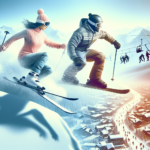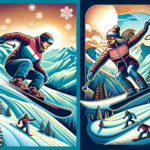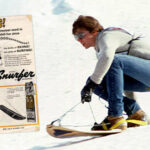You’ve probably noticed the palpable tension that appears on the ski slopes when skiers cross paths with snowboarders. This silent stand-off between the two factions has been an ongoing drama in winter sport circles for years. As you unravel the culture clash in “Why Do Skiers Hate Snowboarders?” you’ll explore the root of this icy exchange, shedding light on long-standing territorial disputes, perceived risks, and contrasting styles. You might just be surprised at what you’ll discover.
Historical Perspective
The tension between skiers and snowboarders is not a recent development; its roots trace back decades.
Origins of skiing and snowboarding
Skiing is an ancient sport, the seeds of which were likely sown thousands of years ago. Snowboarding, on the other hand, is a relatively new kid on the block. It began in the 1960s as a playful fusion of skateboarding, surfing, and skiing. While skiing always held an air of elegance and finesse, snowboarding was born rebellious, adopted largely by the counterculture youth of its time.
Early perceptions and stereotypes of snowboarders
In the early years, snowboarders had a radical reputation, often pegged as rude, reckless, and rebellious by their skiing counterparts. They were portrayed as the disturbance on the slopes, interferers of the serene, calm ski experience. Being the newer, unconventional ‘intruder’, snowboarding had to battle these stereotypes as it sought to carve its space alongside skiing.
Changing dynamics over time
As we consider the history of these two sports, it’s important to note that the dynamics between skiers and snowboarders have evolved considerably with time. What began as hostile rivalry has changed into a somewhat frosty tolerance. This transformation has taken place due to multiple reasons, ranging from a better understanding of both sports to the changing socio-cultural landscape around them.
Cultural Differences
Understanding the differences between skiing and snowboarding requires an examination not only of the sports themselves but also of the cultures surrounding them.
Ski vs snowboard culture
The cultures surrounding both sports can seem like polar opposites. Ski culture is often seen as traditional, privileged, and disciplined, rooted in a love for the mountains and an appreciation for the skill of traversing snowy peaks. Snowboarding culture, meanwhile, emerged from a younger, more progressive background. It has been influenced by the punk and hippie movements and is heavily tied to a chill, freestyle lifestyle with an emphasis on personal expression and fun.
Stereotypes and generalizations
The stereotypes this cultural difference breeds are significant. Skiers are often seen as the ‘grown-ups’ in the winter sports world—wealthy, responsible, and perhaps somewhat uptight. Snowboarders, on the other hand, are supposedly the reckless teenagers—carefree, unruly, and looking for their next adrenaline rush.
Impact of media portrayal
Media portrayal has amplified these stereotypes to a certain extent. Films and commercials tend to depict the snowboarding lifestyle as young and thrilling, while skiing is typically shown as a sophisticated expedition. This has only fueled the tension between the two sports.
Behavioral Factors
One of the key areas of conflict revolves around the behavioral aspects associated with both sports.
Perceived reckless behavior of snowboarders
To many skiers, snowboarders can appear reckless. They take different lines down the mountain and often seem to be in unpredictable motion, behaving contrary to the traditional ski slope etiquette. This has resulted in some resentment, creating a perception that snowboarders are not as safety conscious.
Etiquette on the slopes
Both skiing and snowboarding require certain rules to ensure everyone’s safety. With the difference in approach and style, snowboarders often come off as the ones flouting these rules. But it’s critical to understand that what may seem like reckless behavior could simply be a different way of enjoying the sport.
Safety concerns
Safety is, of course, a major concern on the slopes. The conflicting motion patterns, style disparities, and perceived recklessness of snowboarders have elevated these anxieties. Over the years, several ski resorts have implemented rules and standards to ensure safety and harmony among skiers and snowboarders alike.
Terrain and Slope Damage
The debate is not merely rooted in cultural or behavioral differences; it also involves the physical impact on the terrain.
How snowboarding impacts the snow
Snowboarding has a different effect on the snow than skiing. The sport’s characteristic wide, sliding turns displace the powder differently, leaving bigger, shallow troughs known as ‘snowboarder ruts’ in the snow, which can be a frustration for skiers.
Skier’s preference for groomed slopes
Skiers generally prefer finely groomed slopes, where they can carve patterns exponentiating the thrill of skiing. The unique effect snowboarding has on the snow can disrupt this surface, leading to friction between skiers and snowboarders.
Concerns about mountain preservation
The question of mountain preservation arises due to the varying effects both these sports have on the terrain. While skiing has been asserted as being more environment-friendly, snowboarding often takes the fall for being more destructive. It’s essential that both groups work together for effective mountain conservation efforts.
Skill Difference and Learning Curve
The sports are different not just culturally, and in their impact on the environment; they come with different challenges too.
Difficulty levels in mastering skiing and snowboarding
Generally, skiing is easier to pick up initially but hard to master, while snowboarding is harder to get going but easier to master.
Frustration due to speed disparity
There’s also a speed disparity amongst novice skiers and snowboarders that leads to frustration. Novice skiers tend to move slower, while beginner snowboarders quickly learn to pick up speed, leading to a potential conflict on shared slopes.
Understanding control and maneuverability differences
Snowboarding and skiing differ radically in terms of control and maneuverability, which can negatively affect shared slope experiences. An understanding of these differences by both skiers and snowboarders is crucial for harmonious co-existence.
Economic Impact
The skier-snowboarder discussion isn’t just about personal preferences or cultural disparities. It also affects the bottom line.
Effect on ski resort profits
How skiers and snowboarders get along can have a significant impact on ski resort profits. If a resort is renowned for feuds between skiers and snowboarders, it may deter enthusiasts from both sports, affecting the overall business.
Snowboarding gear costs vs skiing gear
Generally, snowboarding gear is less expensive than skiing gear. The difference in the startup costs for these two sports could affect resort rentals and profits.
Impact on local economies
The trends and preferences can also impact local economies. With towns often dependent on winter sport tourism, cordial relations between skiers and snowboarders become essential for the wellbeing of these economies.
Access to Terrain and Facilities
The schism also appears when we analyze access to terrain and facilities.
Exclusive skiers-only resorts
There are still resorts around the world that cater exclusively to skiers, often citing safety and cultural reasons. This exclusivity fuels the divide between the two sports.
Accessibility issues for snowboarders
Snowboarders often face issues accessing certain terrains due to their equipment. For example, traversing flat stretches is more difficult for snowboarders, which can lead to skiers viewing them as a disturbance or an obstacle.
Impact on ski lift designs
Snowboarding’s unique style and method of transportation has forced adjustments in transport facilities like ski lifts, escalators, and others, influencing the overall design of ski resorts.
Influence of Competitive Sports
Sports events and competitions have also played a role in this dynamic.
Skiing vs snowboarding in Olympics
The inclusion of snowboarding in the Winter Olympics was a breakthrough moment for the sport. However, it still didn’t escape criticism from the traditional skiing fraternity and is often referred to as the lesser sport. This has led to an unnecessary competitive spirit instead of fostering respect.
Role of professional athletes in nurturing rivalry
Professional athletes, too, have not always done enough to reduce hostility. There’s been friction over who owns the terrain, with both skiers and snowboarders feeling entitled to the snow.
Perception created by competitive events
Competitive events have also affected the perception of both sports. With different categories, rules, and athletes, such events often widen the gap instead of bridging it.
Social Group and Generational Gap
The divide between skiers and snowboarders stems from perceived socio-cultural differences.
Skiing as a family or group activity
Skiing is often perceived as a family or group activity. The image of families skiing together has been a part of ski culture for decades.
Snowboarding as perceived youth sport
On the other hand, snowboarding is often labeled as a youth sport, contributing to its image as the wilder, younger cousin of skiing. This perception is consistently reinforced by the media and popular culture.
Understanding the age gap
The age gap further fuels the divide. Older people generally prefer skiing because they’ve been doing it all their lives, while younger people often gravitate towards snowboarding, viewing it as more fun or ‘cool.’
Steps to Bridge the Gap
Even with all the friction and rivalry, there are steps that can be taken to bridge the gap between skiers and snowboarders.
Promoting respect and understanding
The first step is promoting respect and understanding among all slope users. Realizing that everyone is there to enjoy the snow is crucial to fostering a sense of shared camaraderie.
Common rules and guidelines
Establishing common rules and guidelines is vital for sharing the mountain harmoniously. Regardless of whether you’re on a snowboard or skis, respecting others’ space and safety should always be a priority.
Shared spaces could help in developing mutual respect and understanding. Use of the same slopes, lifts, and even common social areas can help build a connection.
Inclusive marketing and advertising
Lastly, inclusive marketing and advertising play a pivotal role in creating awareness and bringing both communities together. Showcasing both skiing and snowboarding as fun, accessible winter sports enjoyed by people of all ages can go a long way in reducing hostility and fostering unity.
In conclusion, while the tension between skiers and snowboarders has historical, cultural, behavioral, and economic roots, it’s essential to remember that we all share a common love for the mountains. By fostering respect, understanding, and unity, we can ensure that everyone has a great time on the slopes, regardless of how they choose to traverse them.
- What Snowboard Bindings Should I Get? - January 23, 2024
- What Size Screws For Snowboard Bindings? - January 23, 2024
- How To Snowmobile On Water? - January 23, 2024










